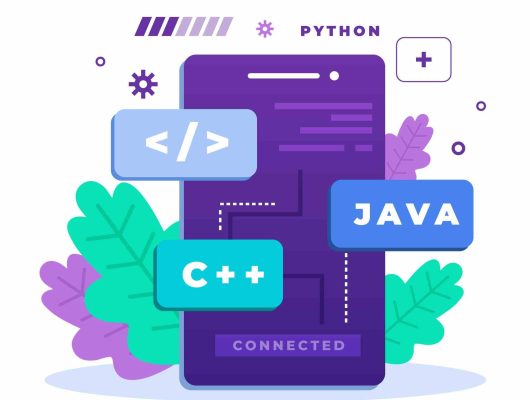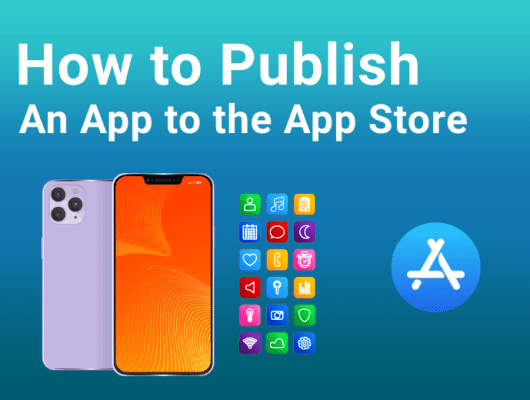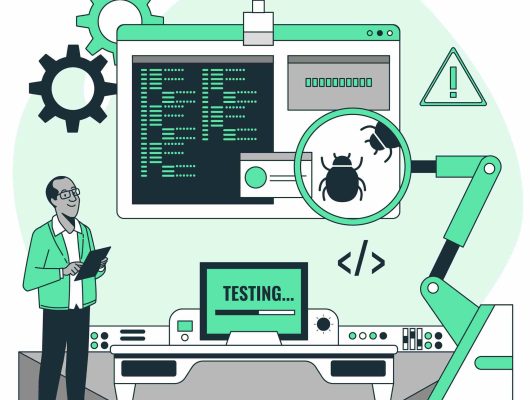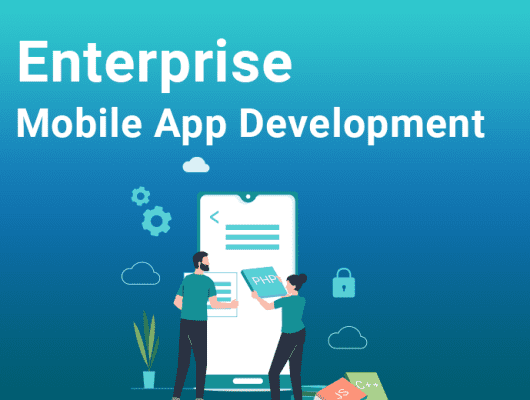
E-commerce App Development Guide
The eCommerce industry has seen significant changes over the previous several years. The pandemic has caused a surge in online shopping, making eCommerce equal to physical stores.
However, developing an ecommerce app involves various intricate steps. You must carefully plan and execute the project to meet the target audience’s specific needs. This includes every phase, from planning to deployment. Each step must be thought out thoroughly to ensure success.
Therefore, most people are stuck with the following queries: What is the best method to develop an e-commerce app? How do you ensure a smooth customer experience from browsing to checkout? What are the best practices for securing user data?
If you need help with these queries, this guide will help you navigate the complexities of e-commerce app development.
So, Let’s begin
Table of Contents
Understanding E-commerce app development
Ecommerce application development is designing smartphone applications that allow businesses to sell and promote their products and services online.
This development process often begins with market research and planning, followed by product design, development, rigorous testing, and deployment.
These applications help businesses to increase their market reach, sales, and consumer engagement. Additionally, features like user-specific product suggestions and faster checkout procedures help to enhance conversions and customer happiness.
For example, a cloth-selling shop invests in an e-commerce platform to extend its market reach beyond its physical store. The app, designed specifically for premium customers, provides exclusive collections, virtual shopping, and individualized styling assistance.
Things to Consider Before Developing a Mobile E-commerce App
Many people view eCommerce as a significant component of the online world, with a large market and numerous uses.
Therefore, before stepping into e-commerce app development, consider the following elements to streamline the development process.
Types of e-commerce app development
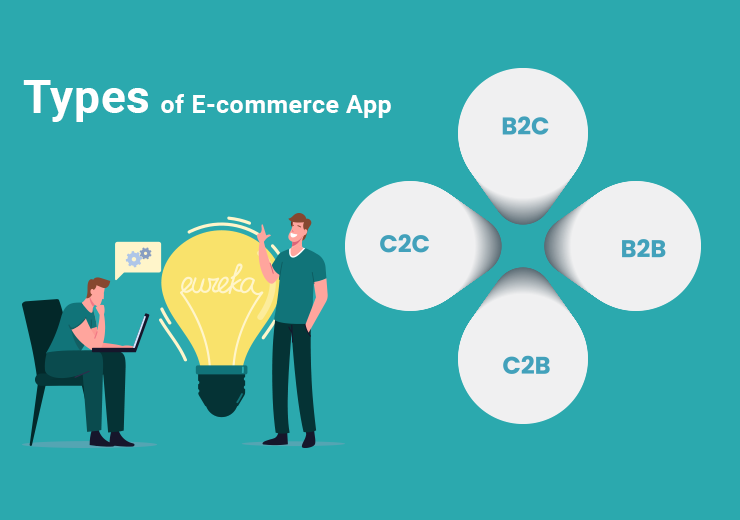
Choosing the application type is the first step in ecommerce mobile application development. As the industry has grown, multiple applications have arisen. Therefore, making this decision while starting your firm is essential to its success. Here are the types that fall under the umbrella of e-commerce applications.
eCommerce aggregator applications
These programs create a smooth connection between service providers and users. Users often use these websites to search for producers and then contact them to purchase items.
B2B eCommerce applications
These apps connect two companies in similar industries, helping them buy and sell goods. Alibaba and Boodmo are the two notable examples of B2B eCommerce applications.
B2C eCommerce applications
These business to customer ecommerce apps are some of the most popular applications in the online market that make it simple for customers to buy things from online vendors. Examples include the Costco, Target, Amazon, Gumtree, and Zara apps.
C2C Customer to customer eCommerce app
The developers designed the architecture of these apps to facilitate buying and selling between end users. These applications, mainly used by home-based businesses, allow users to trade in personalized items easily.
C2B Customer to Building eCommerce app
In this application category, end users provide services to companies. In contrast to product-based approaches, this one is entirely service-oriented application.
Understand competitors and target audiences
Once you have an idea for your digital asset, the next step is to research your competitors and target audience.
This study will help you find the best technologies, design trends, and ways to make money for your mobile app.
You can also go through user reviews to identify the benefits and limitations of current solutions.
Make sure you tailor your application to a specific group of users who are interested in and loyal to your brand. Ensure that you design your application with a specific group of users in mind. These users should be interested in and loyal to your brand.
In addition, determine your primary user by assessing your client base, performing market research, or examining rivals. These two steps result in a general list of app needs and business objectives, which will be the foundation for your app development process.
Gather a trustworthy team
An expert staff of approved mobile developers is another component essential for your application’s success.
So, if you’re developing an application from scratch, the average team structure will contain the following specialists:
- Company analysts: The person who describes company needs and matches them to software.
- A project manager who controls the whole development lifecycle and ensures that the team is on the same page.
- iOS developers are software engineers who specialize in creating applications for Apple devices using iOS-specific technology.
- Android developers are programmers with knowledge of Android-specific technology.
- Backend developers are professionals in data storage and other server-side capabilities.
- Quality assurance team that work on increasing the quality and performance of your application using tests, audits, and validations.
- UX/UI designers who are in charge of your solution’s appearance, functionality, and ease of use.
Additionally, you can recruit software expertise on-site or outsource mobile development to a third-party partner. Remember, outsourcing may cost more but provides good value and maintains software quality. Apart from it, you might accept freelancer bids if you have a specific and focused development assignment.
Choose the Right Platform
Your target audience’s device preferences will help you decide which platform to use for your app. You can choose between iOS (Apple App Store), Android (Google Play), or both.
Consider the devices your audience uses to make the best decision for your app. This selection affects your app’s reach and effectiveness.
For example: focusing on Apple’s App Store could help your app get noticed and accepted if most of your target audience uses iOS.
Define the feature set
When designing the feature set, it is critical to choose features consistent with your company’s objectives and user preferences. This helps ensure that your software provides an optimal user experience.
Consider an online store that sells electronics and can provide detailed information about products, tools for comparison, and reviews from customers. This information can assist customers in making informed purchasing decisions.
What Are the Essential Features of Your E-commerce App?
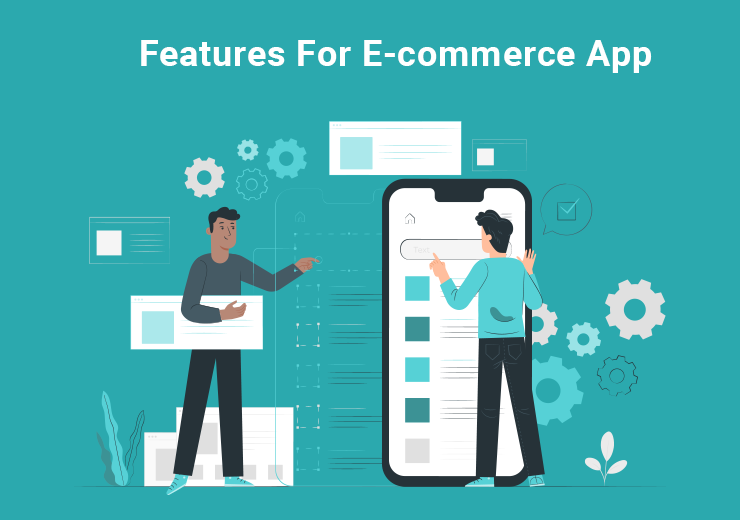
While each e-commerce program is distinct, a good application often includes the following features:
- A quick and straightforward signup method
- User account management
- Advanced search bar and filters.
- Product information that is easily accessible
- High-quality photographs and videos.
- Customer Reviews Shopping Cart
- Wishlist Secure checkout and payment mechanisms.
- Options of shipping
- Push notifications
- Tracking of Delivery status
- Customer loyalty programs
- Refund management
In addition, users may anticipate the following enhanced functionalities in 2024 and beyond:
- Personalized suggestions
- Augmented reality-based product/service preview
- Integration of social media
- Voice and Image Search Multilingual and multi-currency support
Select the development method
A software development methodology explains how to manage your software project. It resonates throughout mobile development, from feature selection to release pace and testing cycles.
Onyxtec approaches mobile development using the Agile methodology. Agile helps our team be flexible, giving plenty of room and time for changes and upgrades.
We also deploy your application in modest increments so that you know the result at each software development step.
Develop and test the MVP
Once you make and confirm your technical and business decisions, it is time to implement all the documentation. Your mobile team should start small, developing a bare-bones product.
This minimal viable product includes basic functionalities. These should be sufficient for people to evaluate your mobile solution. After forming it, you can deploy it to the general public to collect feedback and plan future changes.
Gather user feedback
Once the MVP has been deployed, gathering user input is crucial for determining its efficacy and areas for development. But the thing is
How can you collect this feedback?
This data may be gathered by your internal development team or an external app development business through surveys and user testing sessions.
For example, suppose users of the newly released grocery delivery service need help browsing the product categories. In that case, the team may utilize that input to improve the app’s UX design in future updates.
Plan the process and budget
When planning an e-commerce app, define your project scope, development stages, needed features, and skills. This helps you determine the development cost.
To understand costs, look at industry standards for similar projects. Additionally, consult with e-commerce app specialists to learn about current market prices.
Remember to account for other expenses (such as tech stack subscriptions, digital marketing, and ongoing maintenance charges).
This will help you allocate deadlines and cost estimates to each phase, resulting in a total budget for the e-commerce application development lifecycle.
Furthermore, you can outsource your e-commerce app creation to a nearshore software development partner like Onyxtec. In that case, you will benefit from faster project schedules and a friendly development budget.
Design the User Experience (UX) and User Interface (UI)
The success of your e-commerce mobile application is strongly dependent on its UX and UI, as these two factors directly influence the customer shopping experience.
Here’s how.
UX app design focuses on making apps simple and easy for users to use, helping them complete tasks effortlessly. Whereas, UI app design focuses on individual components like buttons and icons that users interact with.
Conduct Quality Tests and Release the App
Quality testing is an essential stage in which the mobile app is thoroughly checked for bugs, performance difficulties, and user experience faults.
This procedure comprises a variety of tests, including functional testing, usability testing, and security assessments.
Iterate according to feedback and data
Following the app’s release, the next stage is to make ongoing enhancements based on user input, analytics, and mobile app performance data.
For example, suppose data indicates that supermarket delivery app customers commonly leave carts at the payment stage.
In that case, the e-commerce development team might streamline the checkout process by providing one-click payment.
Powerful Technological Stack for E-commerce applications
| Front-End Technology | Back-End Technology |
| HTML | C# |
| CSS | Ruby |
| JavaScript | Java |
| Vue.js | Phyton |
| Node.js | Scala |
| React.js | PHP |
| Angular | Spring and Groovy on Grails |
Process and the Cost of Developing E-commerce App
Developing e-commerce applications significantly influences the project’s success and cost. Let’s investigate the cycle in depth.
App conceptualization
This stage of e-commerce application development is crucial since it establishes the basis for your app’s success.
To understand your product’s audience, you must analyze the market, customers, and competition. This means identifying who uses your product, what features they prefer, and what sets your business apart from competitors.
The typical cost of app conceptualization is between $7,000 and $10,500.
UI/UX design
Once you’ve established your concept, the subsequent stage is wireframing and UI/UX design. Usually, you should focus on creating a simple UI/UX with plenty of white space to prevent a cluttered user experience.
Therefore, the design structure should include vivid images, videos, buttons, and an organic flow of checkout. The typical cost of creating an app is from $2000 to $2500.
App Development
The price of e-commerce software can vary a lot based on features, technology used, and development needed.
To find out how much it will cost to develop a specific project, we need to look at the details. On average, a basic e-commerce software usually costs around $10,000.
Still, a complicated, tech-heavy, and feature-rich application can cost anywhere from $80,000 to $100,000. This range often comprises development time, the cost of leveraging the technological stack, and cloud implementation.
App Testing and Deployment
This stage of the e-commerce app development process involves executing a quality assurance check on the application. Onyxtec takes pride in being a security-first firm, ensuring the app is safe throughout the development lifecycle.
With the increase in hacking and breaches, it’s important to know how to protect e-commerce apps.
App testing typically accounts for 12-13% of the project cost, ranging from $1,000 to $20,000.
Benefits of developing E-Commerce application
Creating an e-commerce mobile app has benefits like saving money and staying ahead of competitors in the market.
Lower Long-Term Expenses
Developing a mobile shopping app can help you manage your products better and work more efficiently. It may cost money upfront, but it will save you money in the long run.
Expanding your market
By using one app, you can reach more customers across different platforms and locations, helping your company grow.
Increased Conversion Rates
Facilitate quicker purchases by offering individualized user experiences and intuitive navigation. Note that more straightforward payment options and in-app alerts increase revenue even more.
Increased User Engagement
Improve user engagement and native app functionality by swiftly deploying and assessing various functionalities.
Advanced User Analytics
To improve products and make more informed strategic decisions, collect in-depth information about user behavior, preferences, and trends.
Personalized Communication
It helps you to increase user engagement by sending them offers and messaging catering to their interests and purchasing habits.
Better User Experience
A well-thought-out e-commerce app can load faster than a progressive web app, making for a more responsive and seamless buying experience.
Greater Competitive Advantage
Set yourself apart by providing distinctive, customized shopping experiences and immediate product access.
Let’s now examine the other side of the e-commerce app development spectrum.
Main Obstacles in E-commerce App Development
While creating an e-commerce app can lead to much potential, there are drawbacks.
Let’s examine this:
- Data and Privacy Risks: User data may be exposed if robust encryption and security measures are not in place.
- Scaling Difficulties: Poor planning for scalability can cause problems with performance at times of high demand.
- Operational Instability: Not updating online shopping apps regularly can lead to crashes and downtime, making customers unhappy.
- Inconsistency in Brand and User Interface: Difficulties in upholding a unified brand and user interface across devices may have an impact on customer loyalty.
- Complexities of Payment Integration: Few payment choices can limit global reach and client convenience.
- Noncompliance: Disregarding data rules and e-commerce regulations exposes oneself to legal issues and erodes trust.
- Supply Chain Disruptions: When this occurs, the app may not display the current inventory levels, which leaves customers unhappy due to purchase delays or cancellations.
- Technological Lag: An e-commerce app may lose customers to competitors. Competitors offer a more interactive shopping experience with augmented reality (AR) product displays. This can attract customers away from the e-commerce app.
However, you can lessen these risks by outsourcing the development of your mobile e-commerce app.
Outsourced development teams provide enhanced knowledge in data security, scaling, rigorous testing, upgrades, and adhering to global standards.
Considerations for developing a eCommerce application
When it comes to eCommerce development, a lot is on the line. Still, scalability, security, and stability are the most important things to remember.
Data safety
Due to the increasing frequency and sophistication of cyberattacks, merchants must implement robust security protocols to ensure their applications are impenetrable. App users also leave private information like card numbers and CVV codes.
Data encryption, security plugins, authentication, two-step verification, SSL (Secure Sockets Layer) protocol, and other safeguards are among eCommerce’s most widely used security measures. Using both techniques together will make your solution more secure, although neither one is enough to stop a hacker.
Additionally, an eCommerce solution must adhere to compliance rules, which impose a number of particular data security requirements.
Consistency
Bugs, glitches, and crashes are the most frequent causes of program malfunctions and general user annoyance.
Therefore, Before deploying your solution to the app store, the development team should subject it to extensive testing in various conditions to guarantee its reliability. Insufficient testing can lead to problems with app stability.
Additionally, mobile developers should use a reliable and tried-and-true framework like Swift and Kotlin when developing their apps. Your IT staff should ensure the solution runs smoothly on various devices without too much CPU or memory. Ultimately, a clutter-free design is the key to keeping your solution dashing on users’ cell phones.
The ability to scale
More than stability and security is needed to propel your application to the top. Your system can only handle increasing users or transactions if it is scalable.
Therefore, your mobile app development team must ensure that your app is scalable. Mobile coders and testers carry out scalable and load testing by purposefully sending your app through several queries to gauge its response time and test its scaling limits.
A mobile app’s architecture should also make it simple for developers to include new features without causing significant hiccups.
Trends in eCommerce 2024
2024 brought numerous trends in eCommerce industry, such as
Chatbox
Customer connection is essential for brands to increase consumer engagement. Customers can interact with a brand more easily when there is communication between them and it. Additionally, prompt response to questions will aid in increasing mobile app conversions.
Moreover, Chatbots increase consumer engagement by giving businesses a way to respond to their questions, engage in marketing, cross-sell, get feedback, and more.
Talking Assistants
In the present era, you can provide a better customer experience if your services are rendered faster. This is precisely what voice assistants do. Customers can explore and search the website more quickly and easily with them, which will be essential for mobile apps in 2024 and beyond.
Large-scale data
Big Data has begun to change how businesses operate in the modern world. It examines user behavior in real-time across several channels, giving the consumer a cohesive and integrated experience.
Note that, analyzing a business’s target audience’s engagement across age groups and demographics can offer valuable information about developing mobile apps for a corporation. The app’s UI/UX can be modified using Big Data to suit users’ demands.
Furthermore, a company’s marketing efforts can be guided by Big Data. It is possible to attain more significant results with data-driven insights.
VR and AR
Virtual and augmented reality seeks to increase user engagement by offering an immersive experience. With AR, users may interact with virtual items in real-world settings. Thanks to technology, a computer-generated image is superimposed on devices.
Moreover, using augmented reality (AR) technology, eCommerce giants such as Amazon, Ikea, and others have enabled customers to see how things will appear in the spaces they want to utilize.
Conversely, virtual reality, or VR, uses technology to replicate a real-world setting in a virtual environment. Users can feel physically present in the three-dimensional environment computers create. Real estate and fashion are two sectors that have greatly profited from virtual reality.
Combining Wearables with Apps
Wearable technology sales have been rising for a while now. Many businesses daily release dependable products with abundant features, providing consumers with a wide selection.
Final Crux
Create a World-Class E-Commerce App with Onyxtec. This top nearshore software development company offers highly qualified personnel, including sophisticated engineering specialists, for all your software development requirements.
We have highly qualified engineers, architects, UX/UI designers, and consultants with extensive experience in various programming languages and cross-platform frameworks.
So, to develop your e-commerce app, get in touch with Onyxtec.
FAQ
How long does e-commerce app development take?
If you want to outsource software development, note that the process can take 3-12 months or longer, depending on the complexity of the mobile app, its features, your team’s skills, and the customization required.
How much will creating an eCommerce mobile application cost?
Various factors, including feature and technology selection, team size, development agency location, and ongoing maintenance activities, determine the cost of developing an e-commerce app. While it is easier to provide a quotation if you know the particular project parameters, the range might be anywhere from $90,000 to $160,000.
How do you design and construct a mobile e-commerce application?
The process of designing and building a mobile e-commerce application begins with a comprehensive market study, finalizing the app’s features and design, carrying out development operations, testing the application, and finally launching it to market.



